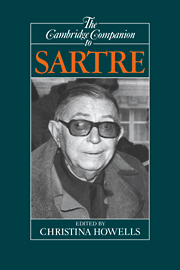Book contents
- Frontmatter
- Introduction
- Part I Phenomenology and existentialism
- 1 Sartre's ontology: The revealing and making of being
- 2 Role-playing; Sartre's transformation of Husserl's phenomenology
- 3 Individuality in Sartre's philosophy
- Part II Psychology and ethics
- Part III History and structure
- Conclusion: Sartre and the deconstruction of the subject
- Appendix; Hegel and Sartre
- Bibliography
- Index
1 - Sartre's ontology: The revealing and making of being
from Part I - Phenomenology and existentialism
Published online by Cambridge University Press: 28 May 2006
- Frontmatter
- Introduction
- Part I Phenomenology and existentialism
- 1 Sartre's ontology: The revealing and making of being
- 2 Role-playing; Sartre's transformation of Husserl's phenomenology
- 3 Individuality in Sartre's philosophy
- Part II Psychology and ethics
- Part III History and structure
- Conclusion: Sartre and the deconstruction of the subject
- Appendix; Hegel and Sartre
- Bibliography
- Index
Summary
In Sartre's ontology what differentiates human being from all other being is precisely nothing. Or more accurately, it is a nothingness. In rewriting the sentence I have subtly changed it. Human being is not the same as the rest of being but is distinguished from it by a separating nothingness. Have I merely effected a sleight of hand? Is this nothingness a futile hypostatization? Or is it in reality a disguised something?
When the Greek Atomists declared that reality consisted of atoms and void, it was easy to grasp that the void was real without being a substance. We can see a hole. Clearly, emptiness was necessary if atoms were to group and regroup themselves in the forms that make up the universe. But the Atomist's nonbeing does not do anything; it is being in the form of self-moving atoms that is responsible for both relative permanencies and change. By contrast, Sartre puts all signifying activity where there is nothingness. And where is this nothingness? He tells us that "Nothingness lies coiled in the heart of being-like a worm" (p. 56). But this metaphor is something of an enigma and requires explanation. One thing is sure: Where there is nothingness, there is consciousness, but the two are not quite synonyms. And in one context Sartre speaks of "little pools of nonbeing" existing out there in the world (p. 53). Consciousness and nothingness are dependent on being, but they are not being. Sartre's ontology is a phenomenological description of the relation of this no-thing, which is consciousness, to the being on which it depends.
- Type
- Chapter
- Information
- The Cambridge Companion to Sartre , pp. 13 - 38Publisher: Cambridge University PressPrint publication year: 1992
- 10
- Cited by



